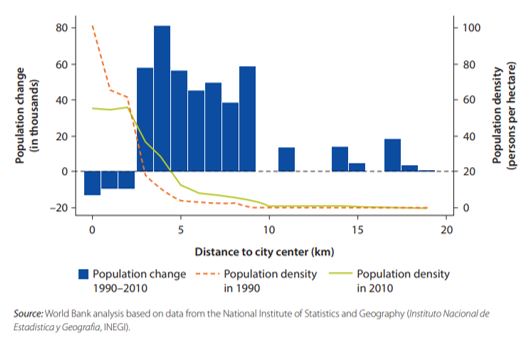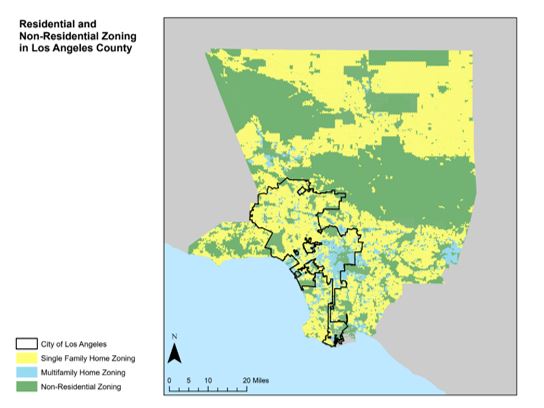Tuesday, March 13, 2018
Rethinking and Expanding Research on Housing Policy with a Global Perspective
Global Housing Watch Newsletter: March 2018
Paavo Monkkonen is Associate Professor of Urban Planning at the UCLA Luskin School of Public Affairs. In this issue of the Global Housing Watch newsletter, Monkkonen talks about housing policy in Indonesia, Mexico, United States, and across countries.
On housing policy in general
Hites Ahir: Is it correct to say that most of the studies on housing policy have focused mostly on ways to subsidize housing or to design financing schemes? Why?
Paavo Monkkonen: It is hard to characterize an entire field, but several dimensions of housing policy that need more attention. Matthew Desmond’s book on eviction clearly demonstrated the importance of the topic in an eye-opening manner, and he makes a similar point about housing vouchers having received a disproportionate amount of scholarly attention. Similarly, Richard Rothstein’s recent book The Color of Law reveals not only the malicious intent of many kinds of land use regulations – especially single-family zoning – but also their lack of justification in the present day. We need more research in several areas, for example, the role of regulations and supply in ‘neighborhood’ housing markets. Also, the way in which policies affect the housing filter, which is essentially the rate at which older housing becomes more affordable and depends to a significant extent on regional housing supply elasticity. Another area is the behavior of property owners, for example, how do corporate vs. ‘mom and pop’ landlords treat tenants. Finally, the role of impact fees – for local community benefits – in the rate of new housing construction merits more study. This is especially important in the United States, where governments are increasingly saddling new development with obligations such as community benefits and contributions to funds for affordable housing.
A big reason is that many of these issues are hard to study. Measuring and modeling the impacts of land use regulations is very challenging, for example, because of problems with endogeneity, the fragmented and inconsistent nature of land use rules in US cities, and inconsistent enforcement across regulatory bodies. Not to mention, high quality data on local regulations and rents are notoriously hard to come by.
Hites Ahir: You have written an introduction to an upcoming Special Issue of the International Journal of Housing Policy (IJHP). In the introduction, you argue that housing policy studies should focus more urban land and planning policies, legal systems, and social movements. Why this is important?
Paavo Monkkonen: In the last two decades, economists have convincingly demonstrated the role of land use rules in metropolitan housing markets. Yet there are many unanswered questions – and consequential political debates – about land use rules in housing supply and rents at the neighborhood level. We also understand that legal treatment of renters and property rights – including enforcement – are crucial for most people’s housing stability. Most international organizations want to support and promote rental markets as a viable option for many people, but how to do it effectively is not yet established. Finally, housing politics is so important because the most well-designed subsidy scheme will be completely ineffective without funding, and funding for housing subsidies depends on political support.
On housing policy in developing economies
Hites Ahir: Land Use Regulations and Urbanization in the Developing World: Evidence from Over 600 cities—is a paper that you have co-authored. In this paper, you find that regulations are more cumbersome in poorer countries. Why do developing economies continue with strict regulations even though they are associated with higher levels of bribery?
Paavo Monkkonen: Well I think that question partly answers itself. Many public officials are able to exploit strict rules to their own benefit. In many cases, inertia plays an important role as well. Colonial governments often set up land use regulations for their sections of the city – large minimum lot sizes, for example – and ignored the rest. Many countries have kept these rules in spite of very low levels of compliance. Changing them would be politically challenging and probably unpopular among civil servants.
Hites Ahir: You have also co-authored a book chapter on Comparative evidence on urban land-use regulation bureaucracy in developing countries. It finds that in most cases, following the law when developing land for urban use is more cumbersome and expensive in Asia than in Latin America. What explains this difference?
Paavo Monkkonen: My answer to this question would be speculative. Moreover, it is a challenge to characterize these large regions where historical patterns of urbanization and governance are so diverse. The hypothesis in Albert Saiz’s important work on land use regulations in the United States is that places with less available land are expected to regulate it more intensely. Given that population densities have traditionally been higher in much of Asia than Latin America, this might be a contributing factor.
Hites Ahir: What are the policy implications from these two papers?
Paavo Monkkonen: One is that higher levels of government – provincial or federal – ought to pay more attention to local rules and their enforcement. One almost universal hindrance to housing affordability (and the environmental sustainability of cities) is low-density zoning. These rules are frequently municipal and I think state (or federal) governments should be more aggressive in curtailing the powers of municipalities over land use in strategic ways to limit exclusion.
On housing policy in specific countries: Indonesia, Mexico, and the US
Hites Ahir: On Indonesia, you have a paper on Housing deficits as a frame for housing policy: demographic change, economic crisis and household formation in Indonesia. The paper shows the challenges of using the concept of housing deficit for policy-making. Could you talk a bit about this?
Paavo Monkkonen: I am often asked how many housing units a city would need to add to achieve affordability. This is a frustrating question, as household formation, migration, and housing production are such dynamic concepts. Instead, we should ask how responsive housing production is in a region to the demand for housing there. It is interesting for me to reflect on this paper about Indonesia, in which I challenge the use of the shortage discourse to support supply-oriented policies there, as currently, California actually does have a housing shortage. The difference in the two places is found in indicators like affordability, migration rates, and household formation.
A global perspective is also important in framing this question of adequate numbers of housing units. In a comparative study of household formation in almost 70 countries, I found an interesting quadratic relationship between levels of economic development and the age at which people leave home and form a household. Figure 1 shows one of these relationships using the idea of ‘childship’, or the age at which people cease to be a child in the census accounts of household structure.
Figure 1. Indirect Median of Childship and GDP per capita (most recent census)
Source: Author with data from censuses obtained through IPUMS International, available at: https://international.ipums.org/international/
Hites Ahir: On Mexico, you have recently written a paper on The Role of Housing Finance in Mexico’s Vacancy Crisis. A surprising finding of the paper is that cities with higher levels of mortgage lending have higher levels of vacancy in the city center but not the urban periphery. What explains this?
Paavo Monkkonen: There are a several reasons. INFONAVIT financing has until recently been directed at new housing in the urban periphery, simply because it was only available for new houses, which were primarily built on greenfield sites. This has led to fewer households rehabbing and inhabiting older, centrally located housing. Of course, there are other reasons leading centrally located housing stock to be vacant, such as the costs of redevelopment, limited infrastructure, negative externalities such as noise and congestion in the city center, and complications with legal title to land and property. In fact, the trend of central city population loss in Mexico is widespread. Of the 91 largest cities in Mexico, 67 lost population in their central two kilometers between 2000 and 2010. Figure 2 below, from the World Bank’s Urbanization Review, shows one city’s recent changes in population density at different distances from the city center. My analysis suggests that the financing system has exacerbated this trend.
Figure 2. Shifting Population Densities in Queretaro, 1990-2010
Hites Ahir: How can policymakers address this issue?
Paavo Monkkonen: Various federal agencies in Mexico are trying to address this problem. The main federal housing finance agency INFONAVIT is trying to direct more financing to ‘used’ housing and housing improvement, rather than new housing. The main federal housing subsidy provider, CONAVI, is directing housing subsidies to more centrally located housing through a system of urban containment perimeters. My critique of that system (here) is that it was limited to CONAVI subsidies not INFONAVIT loans. Table 1 shows where housing loans are going in Mexico, and how this approach has not worked to fund centrally located housing.
Table 1. Share of Housing Loans in Urban Containment Perimeters, 2014-2016
Source: Sistema Nacional de Información e Indicadores de Vivienda; SNIIV, 2016.
INFONAVIT could modify their lending according to these same urban containment perimeters. All levels of government could direct funding to urban upgrading in central cities to improve infrastructure. The corruption in the Mexican housing system that has been carefully documented by the LA Times, must also be addressed.
Hites Ahir: Finally, you have also been working on California’s housing market (here, here, and here). As you know, currently, there is a lot talk about affordability issues. Could you share with us your view on the causes, and how does your view fit with the narrative that is been reported?
Paavo Monkkonen: California’s metropolitan regions have strong economies and growing numbers of high-wage jobs. This attracts people and capital. At the same time, the state and its many local governments have created myriad rules that dramatically limit new housing supply – especially in neighborhoods where people most want to live. One of the most consequential of these rules is single-family zoning. Roughly three quarters of residential land in the City and County of Los Angeles is zoned for single-family houses only (see Figure 3). Single-family houses are roughly 20% more expensive than houses in multi-family buildings. Therefore, local governments could remove their prohibition on the construction of the less expensive kind of housing across the urban area to greatly improve affordability.
Figure 3. Zoning in Los Angeles County
Source: Author with data from Southern California Association of Governments.
Hites Ahir: What has been the policy response?
Paavo Monkkonen: California’s state government has finally begun taking action to address the housing crisis. They passed several laws last year, including SB 2 and 3, which generate more funds for subsidized housing and SB35, which begins to restrict the ability of local governments to block some kinds of new housing. These are laudable efforts but at a small scale considering the housing crisis facing the state. This year, a radical proposal by Senators Weiner and Hueso, SB 827, would override local zoning near transit and allow mid-rise housing. Currently, many cities have single-family zoning next to metro stations and high-frequency bus routes. I think this proposal is at the level of change the state needs, and also addresses environmental goals. Similarly, aggressive proposals to subsidize housing for low-income households at the state and local level – such as through a broad based tax on land – will be important complements. Removing barriers to new construction is a necessary but insufficient approach to ensuring that all households have decent, stable housing.
Posted by at 5:00 PM
Labels: Global Housing Watch
Subscribe to: Posts



